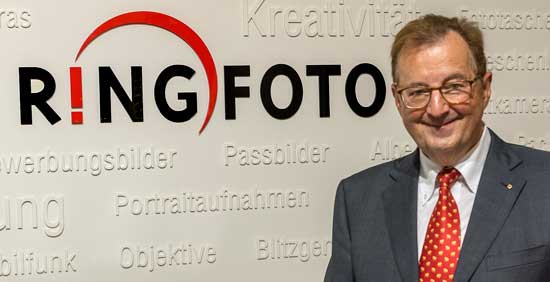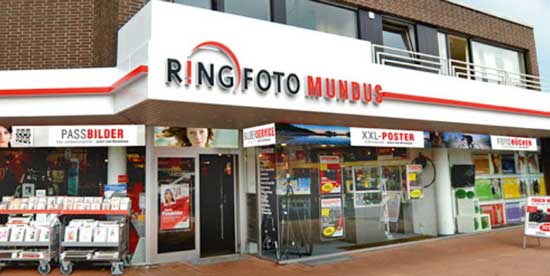At the recent Photokina in Cologne, Australia’s John Swainston spoke to Rainer Schortt, the chairman of the Supervisory Board of European Photo retail Giant, Ringfoto. Here he reports exclusively for PhotoCounter:

In speaking to Ringffoto’s Rainer Schortt you realise the photo retail business still courses through his veins with enormous passion and pride.
He grew up in the town of Gütersloh, famous for the manufacture of Miele kitchen appliances. Born in 1946, from almost his first days, he lay in a pram behind the counter where his mother and father built their photo business largely through the processing of black and white prints for the occupying Allied forces post war. Building on that success they introduced colour and expanded into the eastern part of Germany on reunification with the acquisition of some 20 stores. These days his daughter Katarina is running the resultant business, becoming the third generation involved.
 PC: How did you become involved with Ringfoto?
PC: How did you become involved with Ringfoto?
RS: Ringfoto was formed in 1965. In 1969 I discovered this strong buying group and I felt it would strengthen my own photo retail business. Very soon, as an active young owner, I was making suggestions at regional meetings, focused on improvements we could all make. Speaking up, I suddenly found myself elected to the Board as the youngest ever Board member at 25! Within a year I was vice-chair. In 1991 I was elected chairman because as vice-chairman we couldn’t find anyone else who would take on the workload.
PC: What is the scale of the Ringfoto organisation today?
RS: We have some 2000 members in Germany, Holland, Switzerland, Austria, Belgium and Denmark. For our members and suppliers we can either carry out the full distribution and representation on behalf of those companies that would otherwise find it too expensive, or we can centrally buy and provide central billing. Our central head office revenues, including all services, are over €350M (A$500M), while our member revenues are €1.2B (A$1.73B).
PC: In a world where the best-selling cameras are made by Samsung, Google and Apple, what is the reason a person comes into a Ringfoto store?
 RS: We just do the better job. Our website is the storefront for over 350 outlets, who can have the central warehouse process the order in full, and optionally giving me the opportunity to vary the price from the suggested Ringfoto price, but with Ringfoto doing the work. So Ringfoto is the over-arching brand, but it also gives individual stores their own online business, without all the time-consuming and costly processes of building a unique site. Operationally a member gets all the support they could possibly need so they can concentrate on their business with many of the back-office functions seamlessly supporting them.
RS: We just do the better job. Our website is the storefront for over 350 outlets, who can have the central warehouse process the order in full, and optionally giving me the opportunity to vary the price from the suggested Ringfoto price, but with Ringfoto doing the work. So Ringfoto is the over-arching brand, but it also gives individual stores their own online business, without all the time-consuming and costly processes of building a unique site. Operationally a member gets all the support they could possibly need so they can concentrate on their business with many of the back-office functions seamlessly supporting them.
PC: Is Ringfoto a sort of franchise?
RS: There’s no monthly fee; we gain our margin from the services we sell to members and our exclusive product lines. But for the industry we also back up our name. So, if a member gets into financial problems, Ringfoto guarantees the debt. This is funded in partnership with the industry and especially in these tough times it is a huge, positive reassurance for consumers and suppliers alike.
PC: In Australia and NZ we are seeing declining membership numbers in specialty groups. Is that the same in Ringfoto?
RS: Each year there are some 30-40 members closing or leaving, most often because of intergenerational change, where the children don’t want to carry on that particular family business.
But there are also 10-15 new members each year, so as a percentage it’s a very gradual decline in numbers. But interestingly, despite this in an industry segment that overall declined by 12 percent last year, our business was up 6 percent, so our remaining members are growing confidently and strongly despite so much change.
PC: So, What are the main elements of the business today for a member?
 RS: Today there are three key segments.
RS: Today there are three key segments.
1. Photofinishing, in all its forms;
2. Studio photography of all kinds and outside photography services – strong industry connections, aerial, company leaflet photography, etc;
3. Hardware, of course with all the major camera maker partners, and our own exclusive brand, Peter Hadley, sounding like a pro photographer perhaps, which includes tripods, frames, albums, cases, filters and the like. Voigtländer is a trusted German name in cameras, and we own that. The huge range of lenses that comes with that, including adaptors for the important Micro 4/3 cameras from other makers makes for a highly valued further reason for people to come to Ringfoto. The ultra-fast lenses at 0.9 and 1.1 provide narrow depth of field images that are so different to a phone image with excessive depth of field. Showing the difference and the beauty of these images is so important in the way we make real photography stand out.
PC: Are you more a buying collective or a marketing brand?
 RS: Our website drives our business. But it’s only through our retail members. It creates a high level of trust and consistency. We compete against powerhouses like MediaMarkt and sister company Saturn. They are large format stores with only tiny segment store-in-store offerings in Photo. As they have shrunk those departments our members have stepped up. In the same way Amazon Marketplace provides further competition. But it’s an expensive place to sell, as there is between an 8 and 10 percent margin take by Amazon, and in a world where some categories only have 10 points of margin few people can make money there, or would want to offer their products in such a place.
RS: Our website drives our business. But it’s only through our retail members. It creates a high level of trust and consistency. We compete against powerhouses like MediaMarkt and sister company Saturn. They are large format stores with only tiny segment store-in-store offerings in Photo. As they have shrunk those departments our members have stepped up. In the same way Amazon Marketplace provides further competition. But it’s an expensive place to sell, as there is between an 8 and 10 percent margin take by Amazon, and in a world where some categories only have 10 points of margin few people can make money there, or would want to offer their products in such a place.
PC: How do you cope with price comparison sites?
RS: Well, that technology is now quite well established. If you are not on page one you don’t sell, but if you are, your prices are often incredibly low in margin. And over time we find many of these price-driven retail vendors on websites and Amazon Marketplace have gradually either disappeared or gone out of the sector.
PC: The Internet has reached perhaps 30 percent of the tech sector in retail. It had a rapid growth. Has that now stabilised? What are your observations?
RS: As retailing evolves we find consumers are segmenting. The destination remains very important. But for technical goods, consumers really still do want both touch and information that is harder to find on the Internet than might seem to be the case. When it comes to premium products they need explaining. To sell them well your staff have to be trained, you need higher quality display than a backstreet warehouse that does not provide consumer traffic options or demonstrations. And in Europe your competitor can be over a border, such as the Czech Republic, where costs are completely different, but the goods are next-day delivery away! So the emergence of selective distribution and marketing is an emerging trend that is enabling multiple industries to segment their products and services.
PC: Does this mean some companies will have their full lines subject to limited distribution?
RS: No, it will likely be category selective as well. But in the case of the DSLR or Mirrorless camera, it does require knowhow, a range of options and accessories and choice. Competition is not just price alone and consumers are waking up to the things they miss out on when they only buy on price, and then find their favourite stores are closing up because they weren’t supported.
PC: Ringfoto has an active program for generational transition. What does this provide for members?
RS: My induction into Ringfoto was actually through the German FotoSchule, along with 30 or so similar-aged younger people who were joining their parents’ photo business. That network gave me a wonderful start. We have kept it up to date and rejuvenated, and that process is an essential part of keeping our overall brand and our stores relevant and contemporary.
PC: Photofinishing was such a key part of the business in the past, especially for the margin it provided. How important is that today in your business?
 RS: It’s not the 6×4 print of days before. Today it’s a host of different offerings, including, importantly, output for people’s phone pictures. We have two central partners, CeWe Colour and Eurofoto, a Fujifilm company. And on top of that our stores offer a variety of local print solutions, including kiosk, album, photo book options and at all different price points and quality levels to meet different needs.
RS: It’s not the 6×4 print of days before. Today it’s a host of different offerings, including, importantly, output for people’s phone pictures. We have two central partners, CeWe Colour and Eurofoto, a Fujifilm company. And on top of that our stores offer a variety of local print solutions, including kiosk, album, photo book options and at all different price points and quality levels to meet different needs.
It’s still a vital part of the business and actually it is growing again. Emphasising the value of the print vs all the format changes is important. Digitisation is a solid revenue and margin opportunity and it gives the consumer a great bonus of up to date viewing of content they no longer have hardware to view.
PC: Looking forward, Photokina seems to be two distinct camps. Half the industry is still talking megapixels, the other is reinforcing the fun of photography and all the things it can do. How do you see that?
RS: Talking megapixels today really is not the way forward. It’s about the result, and all the things a special camera can do. One-inch sensor compacts produce remarkable pictures, which are connected and convenient. Looking forward we need connected cameras without needing the phone itself. We have to make it simpler.
PC: What of the future for Ringfoto?
RS: It’s our 51st anniversary this year, and we are gaining share. This year so far, while the industry is down 10 percent, we are up 5 percent. The customer realises that destination shopping that’s done well is fun. The pendulum is swinging. They are learning slowly the weakness of the Internet-only model, which we deal with in our clicks-to-bricks business. In industry gatherings of non-competing companies we share the problems and opportunities from other industries. By bringing those experiences into our organisation, and not allowing ourselves to live in a unique bubble we check ourselves and learn from the experience of other business.
PC: Any magic bullet out there?
RS: No, it’ll be incremental change, despite the disruption. Innovation ultimately has been the heart of our industry since the very first days. The new cameras at this show from Canon and Sony, and announcements by Panasonic for next year will continue to make the journey exciting and a solid foundation for future retail success.
In the past I have thought ‘This is the only camera anyone will ever need. Surely I have no future.’ How wrong I was! Innovation makes life exciting, it’s part of who we are as human beings – our need for better and new capabilities. It is the essence of what drives photography – now and in the future.
– © John Swainston, 2016
(Store photos sourced from Ringfoto.de)





Be First to Comment